Community Profile: Greenwood, Miss., Kitchen Company Keeps Town's Economy Cooking
Photo Gallery | Article
Photo Gallery
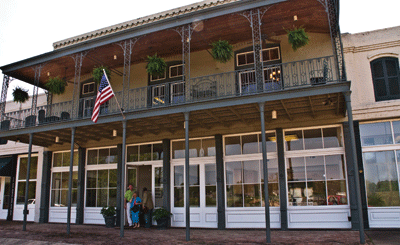
Besides being the top manufacturer and employer in Greenwood, Miss., Viking Range Corp. has been the leader in rejuvenating downtown. Its headquarters occupies two square blocks facing the Yazoo River where cotton traders once did business.
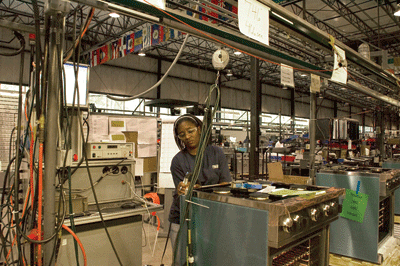
At one of the Viking factories in town, employee Latonja Harris gives a final inspection to a range.
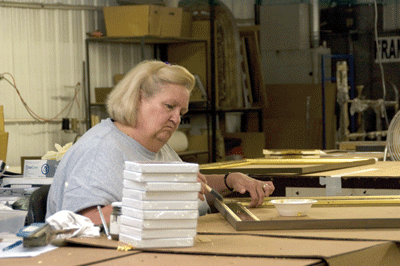
Liz Lester, one of John-Richard’s 250 employees in Greenwood, applies gold leaf to a picture frame.
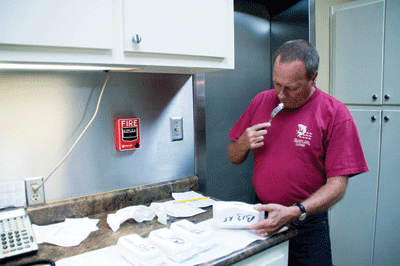
Stanley Marshall, Heartland Catfish’s full-time flavor taster, does his job on a sample he’s just microwaved.
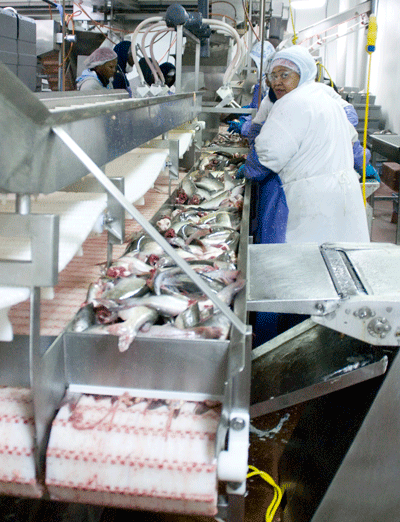
Also at Heartland, an unidentified employee, swathed head-to-toe in her uniform, processes catfish.

On Howard Street, Greenwood’s main retail street, another old building is being renovated by Viking, this one for a furniture store. Also on Howard Street, visitors will find one of the handful of markers in the area that are part of the Mississippi Blues Trail. Among the famous blues musicians with connections to the area are B.B. King and Robert Johnson.
In rich alluvial soil where cotton once was king, the stove now reigns. Since its founding in 1984, homegrown Viking Range Corp. has built a global business in Greenwood, Miss., become the area’s premier employer and helped create an island of relative prosperity in what locals often describe as the poorest region in the nation’s poorest state.
The seed for this success story was planted by the wife and customers of local homebuilder Fred Carl. They kept asking him for restaurant-style ranges for their home kitchens.
Carl conceived and made one. All manner of variations on it followed, as did dozens of other Viking appliances, including disposers, trash compactors, microwave ovens, refrigerators and dishwashers. Now, the founder presides over what he proudly calls an “all-kitchen” company, its brand most recently extended to cookware, cutlery and countertop appliances, designed in Greenwood and made in Europe or China.
Except for these newer, smaller items, almost everything with the Viking name on it is produced in one of the company’s four plants and shipped from its worldwide distribution center, all in Greenwood.
The company’s growth has helped take up some of the job slack created by the flight of other employers, two of them in the early 2000s. First, Baldwin Piano Co. pulled up stakes, laying off the last 275 employees of a workforce that once topped 1,000. Soon, National Picture & Frame Co.’s two Greenwood plants and their 475 jobs had disappeared, as well.
Incentives for Business
Since then, Greenwood has welcomed the arrival of the smaller plants of Raybestos Products Co., which makes brake and clutch products, and Milwaukee Electric Tool Corp., which makes power hand tools. Both companies received economic incentives to come, says Ronnie Robertson, a utility executive who chairs both the publicly funded Greenwood-Leflore Industrial Board and a private economic development foundation.
The two groups combine forces to lure new businesses from out of town. Some are likely to be attracted by the county’s nonunion work environment. Others are drawn in by federal, state and local grants, loans and tax breaks. While declining to discuss specific cases, Robertson says the possibilities for incentives include federal loans for infrastructure improvements and state loans and grants for roads, utilities, building construction, workforce development and the cost of transporting and installing special equipment.
As a result of the state offerings, most new in the past five years, “we are aggressively competing with programs and incentives that are offered all across the country,” Robertson says.
A standard local offer of 10-year abatement on real estate taxes to relocating companies extends at times to existing businesses. Viking got it for the dishwasher plant it finished earlier this year, along with a $3 million state grant to build it. The company also got a $1.3 million state loan to fix up an abandoned building it uses for parts distribution and a call center. The company will own both buildings after leasing them for 10 years.
Viking Doesn’t Roam
Not that Viking needed any special enticement to stay put. Other states have come courting, dangling inducements for pieces of the company’s expanding operations, but to no avail. Carl, a white-haired and cheery man whose favorite term of disapproval is “dad-gum,” insists his company is not—and never will be—in play.
“It just doesn’t feel right. It feels like I would be abandoning my hometown,” says Carl, the fourth generation of a home-building family in Greenwood.
Alex Malouf is no less a Greenwood loyalist. “I was born here and reared here, and I started the business here ... and it’s going to remain here forever,” he says. His business is John-Richard; it evolved from one local furniture store into a worldwide maker and seller of high-end home furniture and accessories.
The company operates a plant in Vietnam and subcontracts work to 17 different Asian manufacturers. But almost all of its worldwide production passes through its Greenwood facilities, where employees also do some of the assembling and hand finishing.
As employers, Greenwood Leflore Hospital and Mississippi Valley State University, a 58-year-old historically black school with 3,000 students, also count among the major fixtures. Another is the farm-raised catfish industry, which Robertson estimates employs more people in Leflore County than Viking does.
The county’s unemployment rate is one of the lowest among 14 counties in the state’s depressed Delta region—a region that consistently registers higher unemployment than the state and nation. But stubbornly high poverty and low education rates combine to limit the pool of job-ready workers.
“The biggest money that’s spent around here is between January and March, when tax refund checks come out,” says Jim Quinn, senior vice president of Planters Bank & Trust of Greenwood.
His bank’s first name speaks to an area rooted in agriculture. Cotton ruled from the early 1800s through about the 1930s. The latest statistics from the Greenwood-based Staplcotn cotton growers co-op show soybeans leading all Leflore County crops, both in acres planted and the crop’s total market value. By both measures, cotton has declined by more than half in just the past three years, the result also of rising corn production and prices.
Cotton remains “a big deal, as big a deal as any other crop,” says Meredith B. Allen, the co-op’s marketing vice president. “It’s just not king anymore.”
Despite highway signs that still advertise Greenwood as the “cotton capital of the world,” that title now belongs somewhere in China, the world’s leading cotton-producing country these days, Allen says.
Catfish Concerns
The soaring global demand driving Leflore County farmers into corn and soybeans—and, says Quinn, ensuring them profits for the first time in several years—is driving up costs for the county’s catfish farmers. That’s because corn and soybeans are the main ingredients in catfish feed, those farmers’ biggest expense. The price of that feed has risen by two-thirds over the past year, says Roger Barlow, president of the Catfish Institute, which is also tracking and campaigning against a tide of imported catfish.
He speaks for a U.S. industry grown up since the early 1980s and centered in Mississippi. Leflore County is home to a number of small operators and two large producers—America’s Catch and Heartland Catfish. Those two have more than 1,200 catfish ponds between them, along with automated plants that process, pack and ship their products.
The changing economic times have affected even Viking. Citing the housing slowdown, Carl forecasts the company’s sales will be down this year from last, snapping a stretch of year-to-year increases of 10 percent and more. He foresees a shakeout in the industry, with Viking winning market share from weaker competitors and proceeding toward his goal of $1 billion a year in sales. “I always wanted to be large,” he says.
The company is forging ahead with new products, including its first commercial ranges, and new projects, including renovation of downtown Greenwood’s former Elks Club into a school for professional chefs.
Downtown’s Revival
Viking’s imprint is already all over that 38-square-block downtown, which dates largely from Greenwood’s boom years of the early 20th century. The company made a headquarters out of two square blocks on the Yazoo River where traders once bought and sold cotton. The company converted other buildings into a cooking school and a training center for distributors. To accommodate them and other visitors to town, it created the boutique Alluvian Hotel out of an old, abandoned hostelry.
Bill Crump, Viking’s director of governmental affairs and Carl’s executive assistant, says the hotel’s opening five years ago marked downtown’s turning point. New book, gift, antique and other stores followed. Now—along with historic sights, museums and various festivals—downtown and the shopping there figure prominently in the marketing efforts of the Greenwood Convention and Visitors Bureau.
More than 50 downtown buildings have been restored since 1995, according to Main Street Greenwood, an organization that promotes downtown revitalization and is responsible for some of it.
Staplcotn has also contributed, spending $4.5 million a few years ago to restore its headquarters in three adjacent 1950s-era buildings.
But Viking has been downtown’s driving economic force, just as it has been for the city in general. Crump estimates that 30 of those 50 buildings downtown have been renovated by Viking—or, in a few cases, by Carl personally.
Carl’s motivation? “The quality of life in Greenwood is good, but the amenities are limited,” making it tough to attract and keep managers from out of town, Carl says.
Most recently, Carl was spearheading an effort to remodel and reopen the town’s only movie theater, closed since 2002.
Locals tend not to differentiate Carl from the company, says Crump. “To the people of Greenwood, Fred is Viking, and Viking is Fred.” And Greenwood has become so much both of them that, says Quinn, “there’s a risk of taking them for granted ... a risk of letting Fred do it.”
Leflore County, Miss., by the numbers
| Total population | 35,088 (1) |
| City of Greenwood | 16,742 (2) |
| Labor force | 14,150 (3) |
| Per capita income | $24,731 (4) |
| Unemployment rate | 8 percent (5) |
| High school graduates | 61.9 percent (6) |
| People living in poverty | 31.6 percent (7) |
| (1) U.S. Census Bureau, 2007. | |
| (2) U.S. Census Bureau, 2006. | |
| (3) Bureau of Labor Statistics, April 2008. | |
| (4) Bureau of Economic Analysis, 2006. | |
| (5) 12-month avarage as of April 2008, compared with 6.2 percent in Mississippi and 4.8 percent for the United States. SOURCE: Mississippi Department of Employment Security. | |
| (6) U.S. Census Bureau, 2000. | |
| (7) U.S. Census Bureau, 2004. | |
| Largest Employers* | |
| Viking Range Corp. |
1,467
|
| Greenwood Leflore County Hospital |
968
|
| Mississippi Valley State University |
543
|
| Heartland Catfish |
400
|
| America's Catch |
380
|
| Milwaukee Electric Tool Corp. |
297
|
| *Self-reported 2008 | |
Views expressed in Regional Economist are not necessarily those of the St. Louis Fed or Federal Reserve System.
For the latest insights from our economists and other St. Louis Fed experts, visit On the Economy and subscribe.
Email Us

